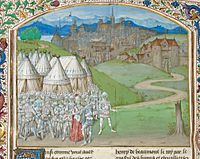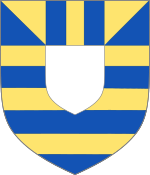Roger Mortimer, 1st Earl of March facts for kids
Quick facts for kids
Roger Mortimer
|
|
|---|---|
| Earl of March Baron Mortimer of Wigmore |
|

A 15th-century picture showing Roger Mortimer and Queen Isabella. In the background, Hugh Despenser the Younger is being punished.
|
|
| Born | 25 April 1287 Wigmore Castle, Wigmore, Herefordshire, England |
| Died | 29 November 1330 (aged 43) Tyburn, London |
| Buried | Wigmore Abbey |
| Noble family | Mortimer |
| Spouse(s) |
Joan de Geneville, 2nd Baroness Geneville
(m. 1301) |
| Issue | Sir Edmund Mortimer Margaret Mortimer Roger Mortimer Maud Mortimer Geoffrey Mortimer John Mortimer Joan Mortimer Isabella Mortimer Katherine Mortimer, Countess of Warwick Agnes Mortimer, Countess of Pembroke Beatrice Mortimer Blanche Mortimer |
| Father | Edmund Mortimer, 2nd Baron Mortimer of Wigmore |
| Mother | Margaret de Fiennes |

Roger Mortimer, 3rd Baron Mortimer of Wigmore, 1st Earl of March (born 25 April 1287 – died 29 November 1330), was an English nobleman. He was a powerful lord who owned many lands in the areas near Wales and in Ireland. He gained these lands after marrying the wealthy heiress Joan de Geneville, 2nd Baroness Geneville.
In 1316, he became the King's representative in Ireland, known as the Lord Lieutenant of Ireland. In 1322, he was put in the Tower of London. This happened because he led other lords in a rebellion against King Edward II. This conflict was called the Despenser War.
Roger Mortimer later escaped to France. There, he met Edward II's wife, Queen Isabella. Together, they led a successful invasion and rebellion against King Edward II. Edward was removed from power, and it is believed Mortimer arranged for his death.
For three years, Mortimer was the real ruler of England. However, he was later overthrown by Edward II's oldest son, Edward III. Mortimer was accused of taking too much power and other serious crimes. He was put to death in London.
Contents
Early Life and Family
Roger Mortimer was born at Wigmore Castle in Herefordshire, England. His birthday was 25 April 1287. He was the first son of Edmund Mortimer, 2nd Baron Mortimer of Wigmore, and Margaret de Fiennes. His grandfather was Roger Mortimer, 1st Baron Mortimer of Wigmore.
Roger's father, Edmund, was originally meant to have a career in the church. However, his older brother, Ralph, died suddenly. This meant Edmund became the heir to the family's lands and titles.
When Roger was a boy, he might have been sent to live with his uncle, Roger Mortimer de Chirk. This was a common practice for noble children at the time. In 1308, Roger Mortimer attended the crowning ceremony of King Edward II. He had an important role, carrying a table with the royal robes.
Marriage and Lands
Like many noble children, Roger Mortimer was promised in marriage at a young age. He was betrothed to Joan de Geneville (born 1286). They married on 20 September 1301, when Roger was 14 years old. Their first child was born in 1302.
Through his marriage, Roger gained many lands in the Welsh Marches. These included the important Ludlow Castle, which became a main home for the Mortimer family. He also gained many lands and influence in Ireland.
Joan de Geneville inherited her titles and lands after her grandfather, Geoffrey de Geneville, 1st Baron Geneville, died in 1314. Roger Mortimer then took control of the eastern part of the Lordship of Meath in Ireland, including Trim Castle.
Military Actions in Ireland and Wales
Roger Mortimer's childhood ended when his father was badly wounded in 1304. Since Roger was too young to take over his father's lands, King Edward I placed him under the care of Piers Gaveston, 1st Earl of Cornwall. However, in 1306, Roger was knighted by King Edward I. He was then given full control of his inheritance.
His adult life truly began in 1308 when he went to Ireland. He wanted to make sure his authority was respected there. This led to conflicts with other powerful families. In 1316, King Edward II made Mortimer the Lord Lieutenant of Ireland.
Mortimer led a large army in Ireland. He forced his enemies to retreat and punished their supporters. He returned to England and Wales in 1318. For several years, he was busy with arguments among the nobles on the Welsh border.
Opposing King Edward II
Roger Mortimer became unhappy with King Edward II. He joined other nobles who were against the King and his close friends, the Despensers. When the younger Despenser took some of Mortimer's lands, Mortimer and other lords began attacking Despenser's property in Wales.
Mortimer led a march towards London. His men wore green uniforms with yellow sleeves. They surrounded London, but Mortimer was not allowed to enter the city. These actions forced the King to send the Despensers away for a short time.
However, the King soon brought the Despensers back. Mortimer then led a rebellion against Edward II, known as the Despenser War. In 1322, Mortimer attacked a town called Bridgnorth. But he was outnumbered and had to surrender to the King. He was sentenced to death, but this was changed to life in prison in the Tower of London.
Mortimer managed to escape from the Tower of London. He fled to France, where he was pursued by the King's men.
The next year, Queen Isabella went to France to talk with her brother, King Charles IV, about peace. In France, the Queen met Mortimer. She refused to return to England as long as the Despensers were powerful. Historians believe their close relationship began around this time.
In 1326, Mortimer moved to Hainault with Prince Edward, the King's son. Queen Isabella then gathered troops in her own region. Mortimer helped arrange a fleet of ships and an army for an invasion of England.
Invasion of England and Edward II's Downfall
On 24 September 1326, Mortimer and Isabella landed in England with Prince Edward. London quickly supported the Queen. King Edward II fled to the west, with Mortimer and Isabella following him.
The King was captured on 16 November. He was forced to give up his throne to his son. His son was crowned Edward III of England on 1 February 1327. However, Mortimer and Isabella were the ones truly ruling the country. King Edward II died in captivity on 21 September that same year. There have been many ideas about how Edward II died, but none have been proven.
Power Gained and Lost
After the Despensers were removed, Mortimer worked to restore the status of his supporters. He gave them back their lands and important positions. Mortimer himself gained many rich estates and powerful offices. In 1328, he was given the title of Earl of March.
However, Mortimer's ambition worried many nobles. His own son even made fun of him, calling him "the king of folly" because of his expensive clothes and spending. During his time as ruler, he took over several lordships. He also spent a lot of money, almost emptying the royal treasury.
Many nobles became angry and jealous of Mortimer's power. In 1330, Mortimer ordered the execution of Edmund of Woodstock, 1st Earl of Kent, who was King Edward II's half-brother. After this, Henry, 3rd Earl of Lancaster, convinced the young King Edward III to take back control.
In October 1330, a meeting of Parliament was called in Nottingham. Just days before Edward III's 18th birthday, Edward and his companions captured Mortimer and Isabella inside Nottingham Castle. Isabella begged her son to have pity on Mortimer. However, Mortimer was taken to the Tower of London.
He was accused of taking royal power and other serious crimes. He was condemned without a trial and put to death at Tyburn on 29 November 1330. His many lands were taken by the crown. His body was left hanging for two days.
Mortimer's wife, Joan, received a pardon in 1336. She lived until 1356 and was buried next to Mortimer at Wigmore. The burial site was later destroyed.
In 2002, a TV show investigated Wigmore Abbey. A document was found where Mortimer's widow, Joan, asked Edward III to return her husband's body. She wanted to bury him at Wigmore Abbey. Mortimer's body had been buried in Coventry by Isabella. Edward III first refused, but later allowed Mortimer's body to be moved to Wigmore Abbey.
Children
Roger Mortimer had three sons and eight daughters. Their marriages helped strengthen Mortimer's power in the west of England.
- Sir Edmund Mortimer (born 1302/1303 – died 1331), married Elizabeth de Badlesmere. Their son, Roger Mortimer, 2nd Earl of March, later got back his grandfather's title.
- Margaret Mortimer (born 1304 – died 1337), married Thomas de Berkeley, 3rd Baron Berkeley.
- Roger Mortimer (born 1305 – died 1328), married Joan Butler.
- Maud Mortimer (born 1307 – died after 1345), married John de Charlton, Lord of Powys.
- Geoffrey Mortimer (born 1308/1309 – died 1372/1376), who inherited lands in France.
- John Mortimer (born around 1310 – died 1328).
- Joan Mortimer (born around 1311/1312 – died 1337/1351), married James Audley, 2nd Baron Audley.
- Isabel Mortimer (born around 1313 – died after 1327).
- Katherine Mortimer (born around 1314 – died 1369), married Thomas de Beauchamp, 11th Earl of Warwick.
- Agnes Mortimer (born around 1317 – died 1368), married Laurence Hastings, 1st Earl of Pembroke.
- Beatrice Mortimer (born around 1319 – died 1383), married Edward of Norfolk and later Thomas de Brewes.
- Blanche Mortimer (born around 1321 – died 1347), married Peter de Grandison, 2nd Baron Grandison.
Later Descendants
Through his son, Sir Edmund Mortimer, Roger Mortimer is an ancestor of the last Plantagenet kings of England, from Edward IV to Richard III. Through Edward IV's daughter, Elizabeth of York, Roger Mortimer is also an ancestor of King Henry VIII of England and King James V of Scotland. This means he is an ancestor of all later Scottish, English, and British monarchs.
On the British TV show Who Do You Think You Are, it was discovered that actress Courteney Cox is a very distant granddaughter of Roger Mortimer.
In Books and Movies
Roger Mortimer appears in several plays and books:
- Christopher Marlowe's play Edward II (around 1592).
- The play Edward III (1690).
- Bertolt Brecht's play The Life of Edward II of England (1923).
- In Derek Jarman's film Edward II (1991), he is played by Nigel Terry.
Mortimer is also a character in Les Rois maudits (The Accursed Kings). This is a series of French historical novels by Maurice Druon.
- He was played by Claude Giraud in the 1972 French TV series.
- He was played by Bruno Todeschini in the 2005 TV series.
Mortimer is briefly mentioned in the 2001 film A Knight's Tale. He is also a character in the miniseries World Without End, played by Hannes Jaenicke.
See also
 In Spanish: Roger Mortimer, I conde de March para niños
In Spanish: Roger Mortimer, I conde de March para niños

